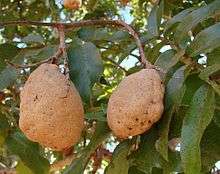Dipteryx alata
| Dipteryx alata | |
|---|---|
| | |
| Scientific classification | |
| Kingdom: | Plantae |
| (unranked): | Angiosperms |
| (unranked): | Eudicots |
| (unranked): | Rosids |
| Order: | Fabales |
| Family: | Fabaceae |
| Genus: | Dipteryx |
| Species: | D. alata |
| Binomial name | |
| Dipteryx alata Vogel | |
| Synonyms | |
|
Coumarouna alata (Vogel) Taub. | |
Baru is a species of the legume genus (Dipteryx alata) in the family Fabaceae. It is a large tree, usually referred to as "Baruzeiro" (Baru tree) in Portuguese, and its fruits and almonds are known as Baru. Other less-used names besides Baru are Cumaru, Cumbaru, Barujo, Coco-feijão, Cumarurana, Emburena-brava, Feijão-coco, and Pau-cumaru.
It is found only in the Cerrado savannah of Midwestern Brazil and part of eastern Bolivia, being threatened of habitat loss by intensive farming. Historically it has been used as lumber, for charcoal production and for shade in pastures. The fruits are used as feed for cattle bovine and are also an important food source for small mammals, rodents, birds, bats, etc. The almonds are highly nutritious and a food source to the local communities.
The tree can measure up to 25 m in height, 0.7 m in diameter and have a useful lifespan of 60 years. A tree will produce about 150 kg of fruit per harvest in alternating years.
Its brown fruits are either collected from the ground or picked from the tree when they are almost ripe. The fruit usually weighs 25g, of which 30% is pulp, 65% is ligneous endocarp and 5% is seed (bean/almond).

Out of the fruit, the pulp is sweet and can be consumed fresh, but is also used to manufacture jams, jellies, and liquors; the almonds are rich in flavor and are typically served after being roasted or as a part of any number of dishes including bread, cakes, Pesto sauce and ice cream; additionally the oil extracted from the almonds may be used as a culinary ingredient or in many other varied forms. Baru is rich in anti-oxidants, proteins, fibers, magnesium, potassium and iron, and has a high energy content.
The uses for the Baru fruit can be summarized as :
| Part of the Fruit | Product/Sub-Product | Uses |
|---|---|---|
| Pulp | Pulp in natura | Human food |
| Animal food | ||
| Medicinal/Pharmaceutical | ||
| Dehydrated Pulp | Human food | |
| Animal food | ||
| Medicinal/Pharmaceutical | ||
| Flour | Human food | |
| Alcohol/Liqueur | Human consumption | |
| Medicinal/Pharmaceutical | ||
| Cosmetics | ||
| Industrial | ||
| Residues | Farming (organic fertilizer) | |
| Almond | Raw almond | Human food |
| Animal food | ||
| Medicinal/Pharmaceutical | ||
| Agricultural (seeding) | ||
| Roasted Almond | Human Food | |
| Flour | Human Food | |
| Milk | Human Food | |
| Oil | Human food | |
| Medicinal/Pharmaceutical | ||
| Cosmetics | ||
| Industrial | ||
| Cake | Human food | |
| Medicinal/Pharmaceutical | ||
| Cosmetics | ||
| Industrial | ||
| Paste/Butter | Human food | |
| Ligneous endocarp | Charcoal | Fuel |
| Pyroligneous acid and tar | Industrial | |
| Ligneous Endocarp | Artisanry | |
Additionally :
| Per 100 g | |
|---|---|
| Protein | 23.9 g |
| Total fat | 38.2 g |
| Saturated fat | 7.18 g |
| Unsaturated fat | 31.02 g |
| Total fiber | 13.4 g |
| Carbohydrates | 15.8 g |
| Calcium | 140 mg |
| Potassium | 827 mg |
| Phosphorus | 358 mg |
| Magnesium | 178 mg |
| Copper | 1.45 mg |
| Iron | 4.24 mg |
| Manganese | 4.9 mg |
| Zinc | 4.1 mg |
| Calories | 502 |
| Wikimedia Commons has media related to Dipteryx alata. |
Sources
- World Conservation Monitoring Centre 1998. Dipteryx alata. 2006 IUCN Red List of Threatened Species.blavla Downloaded on 10 July 2007.
- Chemical composition of seeds and oil of baru (Dipteryx alata Vog.) native from Pirenópolis, State of Goiás, Brazil
See also
Portuguese Wikipedia article on Baru
